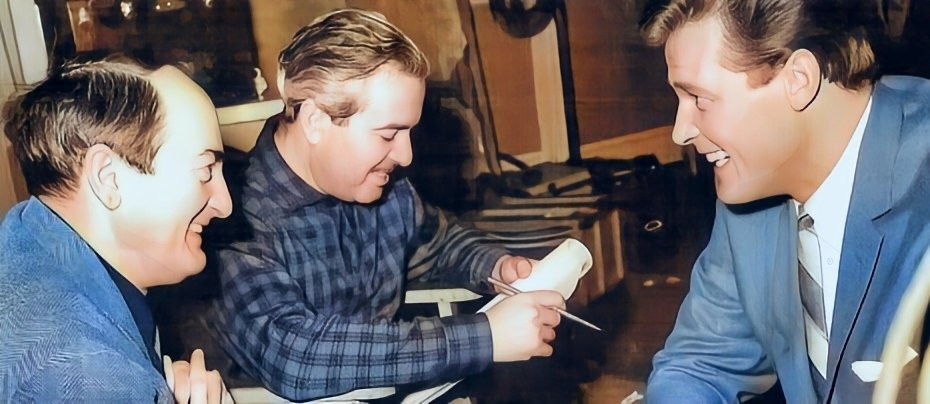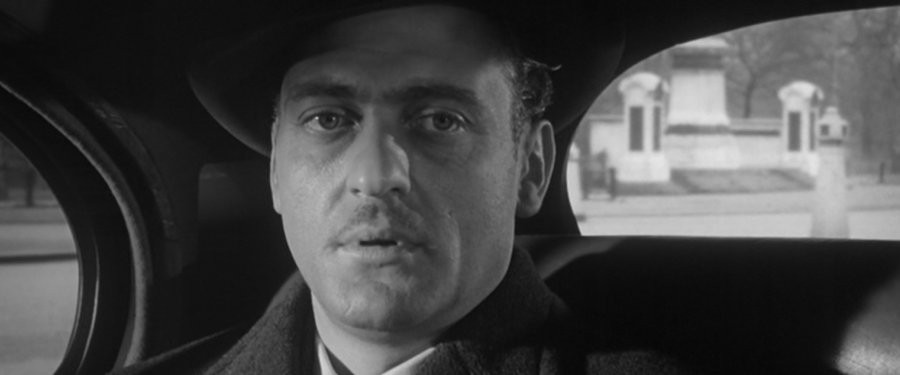
Robert S. Baker and Monty Berman
The Saint had made his screen debut in 1938 in a 69-minute RKO movie entitled The Saint in New York. Louis Hayward was cast as Simon Templar. A second feature was made that year (The Saint Strikes Back starring George Sanders, who would play the lead in several more features), but it was the third film, The Saint in London, made in 1939 that was to sow the seeds for the television series. John Paddy Carstairs directed this movie. Carstairs eventually became very friendly with Leslie Charteris and years later it was he who suggested the idea of a TV series to Robert S. Baker and Monty Berman.

These two prolific stalwarts of the British cinema had met during the Second World War when Baker was working in the Army Film and Photographic Unit as a combat cameraman. Born in 1916 Baker entered the film industry in 1937 as an amateur film maker having won a photographic competition. East End born Berman started his film career as a camera assistant at Twickenham Studios in the late 30's after completing his education at the University College School. When he met Baker when he was working as an established cameraman himself with the British Army Film Unit having served in North Africa, Italy and Germany. The two men hit it off and decided to go into partnership, starting their own film company after the war. The first feature they financed was a movie called Date with a Dream starring Norman Wisdom and Terry Thomas. The film was not a success, but a distributor, Eros, saw it and liked it and with their backing the duo made no less than forty films up until 1960.

The films were all small-budget features and certainly the combination of Baker and Berman showed no signs of setting the world on fire. Then one day they came across a second- hand book on famous crimes in history, which would become something of an inspiration for them. The book sparked off a series of thrillers, which enjoyed a fair amount of success. The first of these was a film based on the crimes of Jack the Ripper. Another film followed based on the exploits of the notorious body snatchers, Burke and Hare. A series of 'B' horror movies followed including Blood of the Vampire, Flesh and the Fiend, and another factual-based tale, The Siege of Sidney Street. During this period they made what Baker was to consider their best film, a war epic called Sea of Sand starring Richard Attenborough.

John Paddy Carstairs knew that Leslie Charteris had been looking for a TV deal for his series of books for some time, but nobody had managed to persuade the author that they were in a position to do the stories justice, and Charteris insisted that the only Saint tales that could be adapted for the small screen were those that he had written himself. As Baker was to acknowledge: "He protected The Saint like a bulldog - and many offers had fallen flat on their face." Charteris himself was to say that: "I can be wrong about lots of things; but on all matters concerning Simon Templar I can cheerfully proclaim myself the one and only infallible incontrovertible expert on Earth. And this I shall continue to maintain, so help me." But on Carstairs' recommendation Charteris met with Baker and Berman and agreed in principle to allow them the rights for a series. The first television company that the producers went to was Associated Redifussion. However, when Baker requested a budget of £16,000 per episode, AR's Brian Tessler turned it down. Baker then went to see Lew Grade. Baker already knew Grade and of his reputation for commissioning whole series' on instinct. Within five minutes of meeting Baker, Lew Grade gave the go-ahead. Baker immediately flew out to Florida, where Charteris was living at the time, and spent a week of intense haggling with the author. Although Charteris had agreed to the series in principle, he still wanted creative control over the series as well as more money. In the end Lew Grade announced that the initial 26 episode series would be shot on film rather than the cheaper telecine and increased the budget to £30,000 an episode. Charteris relented on creative control and the deal was done.
Grade knew that by shooting the series on film he would be able to sell it to the USA. "None but a fool makes television films for the British market alone." He said in 1958. "Without the guarantee of an American outlet he will lose his shirt." As Baker would acknowledge years later: "Lew is the greatest deal-maker in the world. He's the last of the great showmen." Indeed, Lew Grade's faith in the series was fully realised as the series (plus the five that followed) was eventually sold to 63 countries around the world and reaped a profit in excess of £350 million.

To begin adapting some of Charteris' 70 or so stories, the producers brought in respected Canadian story editor Harry Junkin, who had worked for many years on a US soap opera called Love of Life. They then turned their eye to casting the all- important lead role. Lew Grade suggested Patrick McGoohan, who had been a great success as secret agent John Drake in Danger Man. In fact it was that series that Grade picked out as the one that helped him break into the vital American market (it was shown as Secret Agent in the US). "There was a period of about six years when nobody wanted British TV programmes." Said Grade in 1966. "It was really Danger Man that broke the bad run -and since then we have never looked back." But the producers decided that McGoohan lacked the lightness of touch that the character of Simon Templar required, and for McGoohan's part, he wasn't happy with the The Saint's promiscuity. So the role went to 34 year-old Roger Moore who had been seen on UK television in the children's adventure series Ivanhoe, before going to the US to star in the Western series Maverick.
Although an instant success in the UK, The Saint didn't make the inroads into US television that Grade had hoped for. It was shown in syndication during the early sixties but failed to secure a regular spot on network television. It wasn't until 1966, when a show was needed to fill the summertime slot vacated by The Dean Martin Show, that the series began to take off. At the suggestion of Lew Grade (who was on good terms with the executives at NBC), The Saint was put up against rival CBS' first run of classic Hollywood movies. In spite of reservations by the NBC executives, the series became an overnight success and the network ordered 47 more episodes and this time in colour. By this time Monty Berman had left the series to create other British hit shows such as The Baron, Department S, The Champions and Randall and Hopkirk (Deceased). Berman had a wonderful intellect and imagination and loved films and hatching concepts for new productions. He rarely became flustered and was known for his acute realisation of the public's love of action and adventure. "I believe in giving people what they want," he said simply - and by giving them what they want in feature and television films he became one of the most successful of British producers.

Bob Baker went into co-producership with Roger Moore and together they formed a company called Bamore. By now there were not many more Charteris stories that the producers considered suitable for adaptation, and although a few reworkings were made most of these last 47 were original tales.
Undoubtedly, The Saint was one of the flagship shows of Lew Grade's ITC company and helped to usher in a whole new era of British television. Where British television had once been staid and predictable Baker and Berman's series helped establish a new formula for fast paced action packed adventures. From their small but influential position as mainstays of film production in the UK through to their long and impressive contribution to classic British television, both together and apart Robert S. Baker and Monty Berman consistently provided viewers with world-wide with slickly produced, glossily presented and memorable entertainment. If the 1960s-70s were twin decades which truly represented a genuine Golden Age for British television, then the shape, intuitive and creatively imaginative team of Baker and Berman were certainly an integral component stamping those decades with the illustrious hallmark of genuine quality.
Published on February 20th, 2019. Written by Laurence Marcus (2003) for Television Heaven.









